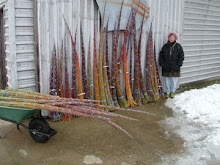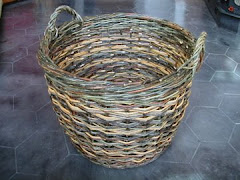A sunny day in mid-September 2006 saw us heading up the Bruce Peninsula to Tobermory to take the Chi Chee Maun ferry across Georgian Bay to Manitoulin Island. The van was tightly packed with soaked willow for a week's basketweaving. We took three days to drive to Thunder Bay and tented along the way but the weather had turned by the time we camped on Agawa Bay at Lake Superior Provincial Park. I can't believe we paid a premium for a beach site! It blew rain all night and we will always remember the sound of the booming surf. My first time up that way, the drive was nevertheless beautiful and the fall colours were at their peak.We were welcomed with open arms by Judy and Gerry Nichols at their rural home right on Lake Superior and the basketmaking began that evening. We took a look at my large bundle of soaked willow and planned our projects. With the help of friend Sherry, we set to work skeining the larger willows while Ralph worked at making a sharp-bladed tool to refine the skeins.
Some interesting black walnut "slices" would be the bases of two large beauties featuring scallomed stakes and fitching (twining with a twist). We set up practice stakes in blocks to teach ourselves how to fitch properly. It took more than a day to figure out the technique from our books and to gain enough confidence to begin. The finished baskets are quite spectacular, but we're probably biased.
Our next project was a breadbasket from the book, Willow Basketry, by Bernard and Regula Verdet-Fierz - the definitive willow textbook. New techniques we learned were a French randed oval base, weaving with skeins, a top wale made of a split rod lashed with a skein to the stakes and a braided border. My stakes are red osier dogwood making the burgundy border quite a contrast to the green and gold willow in the basket.
The final evening, we held a mini-workshop for some friends and neighbours. Guild member Sharon Breckenridge was there too. The project was a tension tray made with my coloured willow and resulted in a variety of beautiful trays, everyone had fun. The week had been given over completely to basketmaking - what a luxury! Support staff Gerry cooked wonderful meals with a bit of help from Ralph. Together they even found time to take out the windows in the dining room and install a set of French doors.
Too quickly it was time to head south through more rain but I couldn't seem to stop weaving baskets, taking along a supply of willow and creating a small spiral weave basket en route, whipping the long-suffering driver only slightly. We're planning a return trip in 2008 - can't wait!

















































